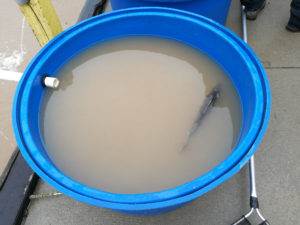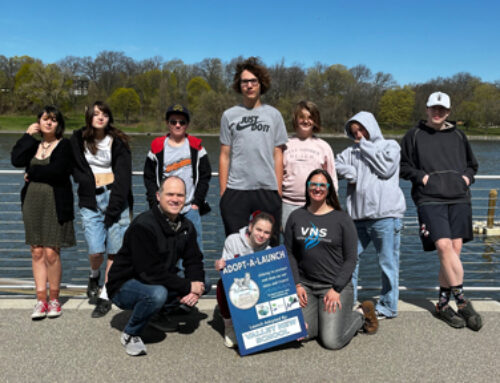Suspended solids refers to a water quality parameter measuring particles that have not settled out of the water. Solids can be anything from organic matter to tire particulates washed in from roads. Solids are filtered from a water sample, dried, then weighed to measure total suspended solids (TSS).
How do they affected water quality?

Cloudy Lake Winnebago water affected by high levels of SS
Suspended solids can block light similarly to how algae mats inhibit light from reaching plants. The resulting decreased level of photosynthesis leads to suppressed levels of dissolved oxygen (oxygen is a product of photosynthesis). The bacteria that decompose the dead plant matter use up remaining oxygen when SS levels are so high that photosynthesis ceases and vegetation dies off. Additionally, SS raise water temperatures because the suspended solids absorb heat. This is a problem because warm water holds less oxygen.
Suspended solids further impact aquatic life by reducing visibility (important for finding food, suitable habitat, locating mates), clogging fish gills, reducing growth rates, decreasing disease resistance, and impede egg development. SS also smother hatching eggs, and SS fills in gaps in the bottom substrate that could be used as shelter for organisms or eggs. Suspended solids also bind to other pollutants such as pesticides, bacteria, nutrients, and heavy metals, which then enter our water bodies when the SS get carried away in runoff.
How do SS enter our water bodies?

Cloudy Winnebago waters at High Cliff State Park
Suspended solids enter a system when water picks up sediment and transports it to surface water. Areas where soil is devoid of vegetative cover, such as bare agriculture fields or construction sites, are highly susceptible to erosion. Heavy rain events destroy soil structure and carry sediments to water bodies. Urban areas lack the capacity to absorb water where it falls. Storm water picks up debris, pollutants, and soil particles where they enter storm drains leading to our water bodies. Additional SS enter the Winnebago system through wastewater and septic effluent, when the lake bottom is disturbed, and from organic particles released by decaying organisms.
Current work is being done to measure total suspended solids in the Winnebago system. Measurements will guide lake management plan recommendations. Click here to read a Lake Winnebago system water quality report that has a strong emphasis on the effects of TSS.
Winnebago Waterways is a Fox-Wolf Watershed Alliance program. The Fox-Wolf Watershed Alliance is an independent nonprofit organization that identifies and advocates effective policies and actions that protect, restore, and sustain water resources in the Fox-Wolf River Basin.
Follow the Fox Wolf Watershed Alliance’s Winnebago Waterways Program on our Winnebago Waterways Facebook page or @WinnWaterways on Twitter! You can also sign-up for email updates at WinnebagoWaterways.org.
This article was written by Austin Pethan for the Winnebago Waterways Program.





